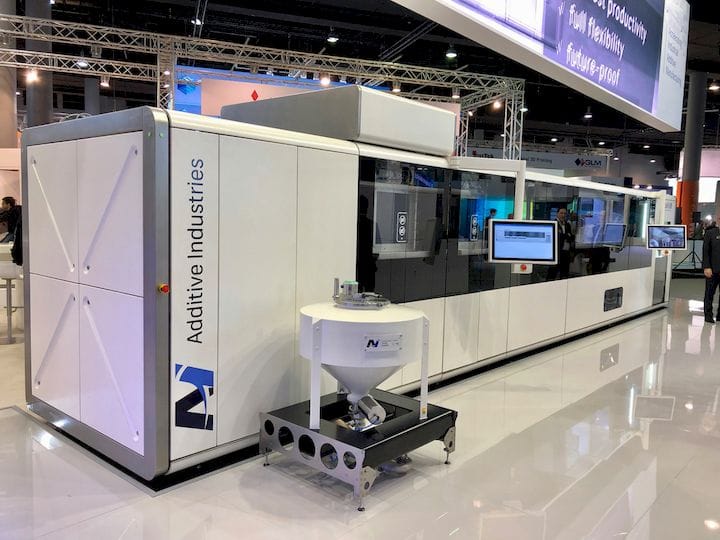![Additive Industries’ METALFAB1 is the product of a very careful strategy [Source: Fabbaloo]](https://fabbaloo.com/wp-content/uploads/2020/05/image-asset_img_5eb0a270070de.jpg)
Last week we heard from Additive Industries, who continue to prove they know how to 3D print in metal.
We have been following the Eindhoven-based company for several years, even before they launched their first product. Now, the company seems to be successfully leveraging their skills through a sophisticated growth strategy. While they are “almost” profitable as they now emerge from the startup stage of development, they are quite a large company now, with 33 recent hires and an expectation to add another 23 positions worldwide. To house all these people, the company recently moved into a bright new headquarters in Eindhoven.
I’m impressed with their strategy; let’s go over the highlights.
Like several companies offering high-tech solutions, Additive Industries has been setting up new customer centers in different regional locations. Each center will have a specific application focus, allowing for concentration of expertise.
These facilities will be used to provide live demonstrations of their equipment, offer technical training and even print samples for curious prospects. This is a very good move, as there are vast numbers of metal product companies who do not yet understand the nature of metal 3D printing. They’ll soon get their answers by visiting one of Additive Industries’ centers.
The centers are located in (not surprisingly) Eindhoven, focusing on hardware and software competence; Bristol, UK, focusing on materials; Camarillo, California, focusing on manufacturing; and Singapore, focusing on industrialization.
As Additive Industries’ Daan Kersten explained to us, these centers also provide a platform for the company to develop additional trained talent beyond their original home in Eindhoven. Kersten appreciates their start, but says that it’s beginning to get more difficult to recruit within that area due to their growth.
A powerful technique often used by Additive Industries is their measurement and analysis approach, which we’ve seen several times in the past. This time they explained a few more.
One is their “PRL” rating system for materials and associated processes. “PRL” stands for “Process Readiness Level”, a system for ranking the production viability of a given process. In this case Additive Industries has wisely chosen to bundle material with process, as they are intimately related in the process of metal 3D printing.
PRL levels are formally defined from level 1 to 9, and include these groupings:
-
TRL1-4: Research and development only
-
TRL5-6: Ready for beta testing
-
TRL7-9: Production ready
Additive Industries has also taken a very precise look at the entire end-to-end process of 3D printing in metal in an effort to optimize the process. Their fundamental axiom is that it’s a lot more than “just the printing”, and indeed their machine, the METALFAB1, is itself designed around that concept, having multiple modules smoothly handle stages of production beyond “just the printing”.
Because of their detailed look at the process, they have now developed productivity metrics for metal 3D printing that could very well be used by others in the future.
![Additive Industries’ Daan Kersten showing their new productivity metric [Source: Fabbaloo]](https://fabbaloo.com/wp-content/uploads/2020/05/image-asset_img_5eb0a2706c1dc.jpg)
In the diagram shown here by Kersten, we can see they take into account the machine capacity as well as the hours of use and completed volume of prints. This is the first time we’ve seen such analysis from any 3D printing company.
I suspect we have not seen this type of analysis from others because they do “just the printing”.
This productivity analysis has allowed Additive Industries to adjust their development processes to focus aspect that directly benefit the productivity metrics – and thus make customers a lot happier when more prints are able to be completed.
![Metal 3D printing process analysis by Additive Industries [Source: Fabbaloo]](https://fabbaloo.com/wp-content/uploads/2020/05/image-asset_img_5eb0a270ade71.jpg)
Additive Industries says they now have a software tool that can process all the quality metrics they’ve defined, particularly on their own equipment. In fact, they can now provide productivity and quality measures down to individual components within their METALFAB1 system. Impressive!
Another very interesting update is that their control software now permits much more control over laser usage. They can, for example, now ensure a specific laser is used to fuse the outer surface of a part, ensuring a better surface finish.
![Laser optimization using Additive Industries’ new tools [Source: Fabbaloo]](https://fabbaloo.com/wp-content/uploads/2020/05/additive-laser-1_result_img_5eb0a270ee6c8.jpg)
Their machines are networked and Additive Industries is collecting data on successes and failures of many print jobs. I suspect they will be using this data to develop even more numerically-driven strategies in the future to improve their products.
They said this feedback system is the world’s first in 3D printing, but I think it may not be, as Formlabs has included a feedback feature on their Form 2 device, where the operator indicates success or failure on each job. Formlabs and Additive Industries are quite similar in many ways, although their 3D printers are vastly different.
Finally, Additive Industries announced a partnership with Volkswagen, one of the world’s largest automakers. Additive Industries have implemented at least one system at the company, with apparently more to come.
In my experience, well managed companies inevitably do well, and that is precisely what I see in Additive Industries
Via Additive Industries











